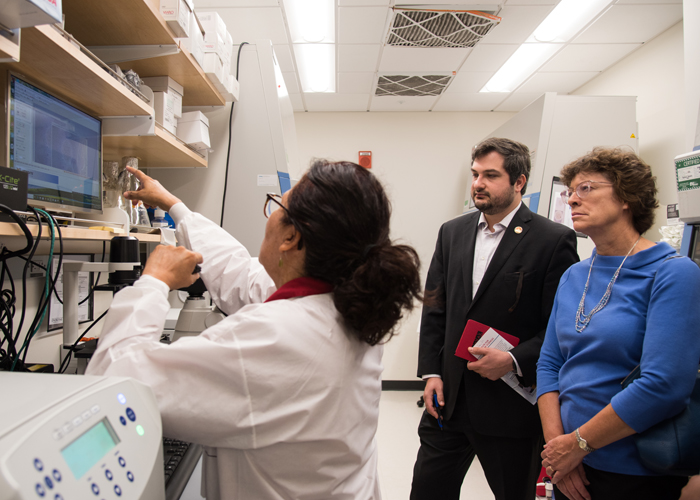UMB Innovations Impress Congressional Delegation
The grand opening may be a few weeks away, but staffers from Maryland’s U.S. congressional delegation got a sneak peek Aug. 14 at Health Sciences Research Facility III (HSRF III), the newest research facility of the University of Maryland School of Medicine (UMSOM). The cutting-edge facility was the first stop on a tour meant to introduce the delegation to the new innovations and initiatives happening at the University of Maryland, Baltimore (UMB).
“It’s always important to get [congressional] staff on campus to see what we have going on,” says Jeff Grossi, JD, senior government affairs specialist. “It allows better opportunities to build relationships, and more than anything, it reinforces the need for continued federal investment in academic research and investment in higher education at the graduate level.”

Researchers from the University of Maryland School of Medicine introduce the congressional delegation to their innovative cell research in the state-of-the-art laboratories of HSRF III.
The daylong tour began in the pristine lobby of HSRF III. UMB President Jay Perman, MD, greeted members of the congressional delegation with warm handshakes and a few words about how imperative UMB’s research is to solving global health problems, creating advanced medical practices, and, most important, saving lives.
“This facility isn’t filled with investigators only looking into biology,” Perman explained to the delegation. “It’s filled with investigators helping clinicians, like me, who take care of babies in their work.”
(View a photo gallery.)
HSRF III will have its grand opening in September 2018, but investigators were able to begin their life-saving research programs in January. Using state-of-the-art laboratories, researchers from UMSOM have been able to collaborate on groundbreaking research in cancer, metabolic and infectious diseases, women and children's health, and brain development using front-line genomic sciences.
“We designed an open-lab type of setting,” said Jacques Ravel, PhD, associate director of the Institute for Genome Sciences at UMSOM. “We want to physically encourage the sharing of ideas and collaboration among professionals because that is how new innovations are discovered.”
After viewing HSRF III, the congressional delegation was introduced to oncology research in the School of Medicine, clinical simulation labs in the School of Nursing, and the work of the Center for Addiction Research, Education, and Service before traveling across Martin Luther King Jr. Boulevard for an up-close look at the positive footprint UMB is leaving on the West Baltimore community.
The tour first stopped for a walk-through of the Grid (Graduate Research Innovation District). Established last year, the Grid is designed to bring innovative health and social impact ideas to life by supporting entrepreneurial ventures through education, early stage funding, and programming. The space will soon be home to a degree program in health and social innovation that will allow UMB students to concentrate in areas such as health science, user experience, and biomedical entrepreneurship. The program is set to launch in fall 2019.
The Grid also provides educational opportunities for local entrepreneurs in the greater Baltimore community such as business workshops from the Small Business Development Center and programs that include free legal consultation from UMB law students. The facility’s educational services go hand-in-hand with the health and recreational services provided just a few blocks away at the UMB Community Engagement Center (CEC).
“We are very highly committed to being part of the community, and you can see that in our Community Engagement Center,” Perman told the congressional delegation.
The congressional staffers were able to see that commitment firsthand on their final stop of the tour by taking the short walk over to the CEC, located adjacent to the Poppleton neighborhood. As Ashley Valis, MSW ’06, executive director of strategic initiatives and community engagement, explains, the center's location was an important part of earning the trust of the community.
“We wanted to break down the barrier between the University and our West Baltimore neighbors,” Valis said. “[The CEC] has been open for about three years, and in that time we have established a presence in the community and our neighbors have really taken to that.”
The CEC’s mission is to bring the University and its West Baltimore neighbors together to strengthen community relationships and improve residents’ quality of life through a number of free services including health care programs, exercise classes, workforce training, and after-school activities for children. The CEC also hosts weekly food markets, providing the community with a convenient and cost-effective way to purchase fresh and nutritious foods.
Valis told the congressional delegation that UMB hopes to continue catering to the community’s needs by expanding the CEC to a larger second location. The additional space will provide the West Baltimore community with even more opportunities and will continue to strengthen the community’s relationship with the University.
The visit to the CEC completed the congressional delegation tour, which started in a beautifully finished medical research facility and ended in a small community center that’s working toward expansion and growth.
“When you look around this University, you can see the magnificent construction and architecture and you can also see a community that needs a lot of help,” Perman told the tour group. “Those two bookends together are what make UMB.”



